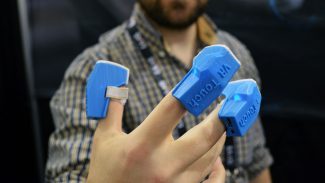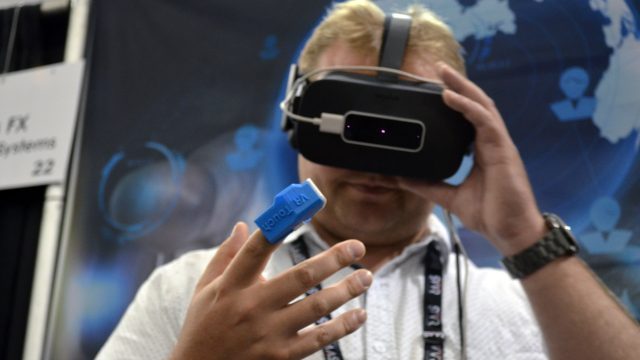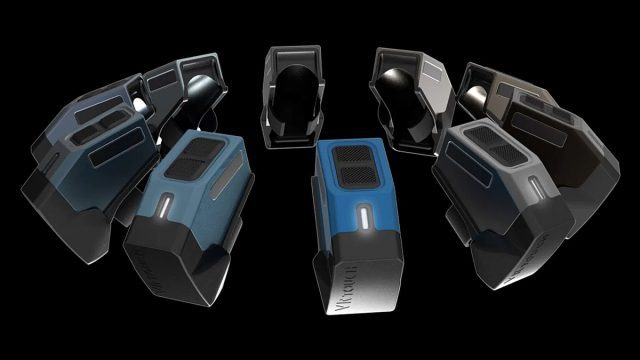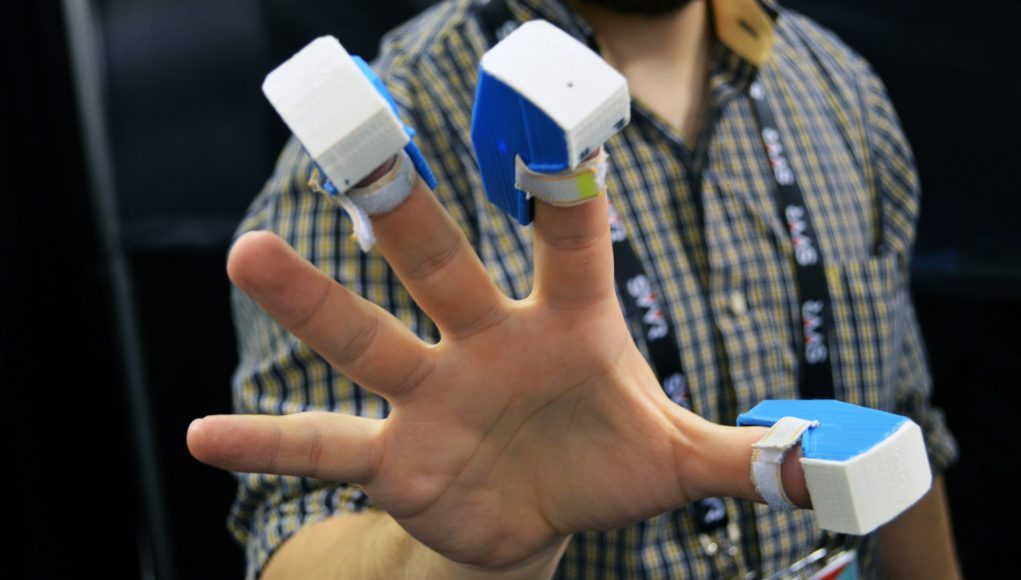Sometimes, the simplest solutions are also the smartest. Go Touch VR’s approach to VR haptics achieves surprising effectiveness out of small, simple haptic devices that provide stimulation to the end of your fingers.
Call it “obvious,” but this is the first time I’ve seen Go Touch VR’s approach to VR haptics, which provides nothing more than a variable force against the top of your fingertip using a flat piece of piece of plastic that moves back and forth with a little motor. Simple, and yet surprisingly compelling. The sensation is much like what you feel when you press your finger against a flat surface like a desk.
While oldschool ERM rumble (like you’ll find in today’s gamepads) and more modern linear-actuator based rumble (like you’ll find in VR motion controllers) both offer various rumbling sensations as an added dimension of feedback to users on top of visual and audio cues. And while sometimes that rumble can be interpreted as direct feedback (ie: vibration caused by shooting a gun leads your hand to rumble), often times the haptic sensation is a bit more abstract than that, like feeling a rumble when you press a button; but pressing a button doesn’t exactly cause your hand to ‘rumble’ in real life, and thus the rumble in this case is abstract rather than direct (ie: it requires a level of interpretation from your brain to make the connection between the information being conveyed and the sensation).
And while rumble is widely applicable for that abstract approach, it seems best suited for shooting games if you want to make use of the more immersive direct approach. And yet in VR we find lots of experiences where you aren’t shooting, but are instead grabbing, touching, and manipulating objects in VR which wouldn’t vibrate in real life, making it difficult to use rumble to convey meaningful, direct feedback.

It’s that grabbing, touching, and manipulation where Go Touch VR’s ‘VR Touch‘ haptics hopes to excel. Based on what CEO Eric Vezzoli says is a ‘Real Contact Sensation’ haptic approach, VR Touch is a simple, compact device which straps to the end of your fingers and provides nothing more than a plastic pad which can exert varying levels of force against the top of your fingertip.
That force can create a surprisingly compelling sensation of touching and grabbing objects with your fingers. Rather than abstract rumble, VR Touch gives the illusion of objects pushing back against your fingers directly.
For non-controller VR input solutions like hand tracking, VR Touch fills the significant need of informing the user when they have actually initiated a ‘grab’ of a virtual object; having something that is not your own fingers to push back against your fingers as an indication of contact turns out to be far more immersive than the ‘air grab’, where you create a grabbing gesture with your hand, but have no idea if you are making the ‘correct’ contact with the virtual object because there’s no real object providing feedback to your fingers. This issue presently plagues non-controller VR input, and it’s one that VR Touch is poised to solve.

Demonstrating VR Touch haptics at SVVR 2017 this week, Go Touch VR showed the device in action using an Oculus Rift with attached Leap Motion for hand tracking. They placed three of the VR Touch units across my thumb, index, and middle fingers, secured with a small elastic band with velcro.
Through the series of demos, I found that the VR Touch haptics are great for things like pressing buttons and poking & grabbing objects.
Again, the key is providing useful feedback to indicate that your virtual fingers are interacting with the virtual objects. But it isn’t just useful; the sensation is a good stand-in for the forces you expect to feel and the places you expect to feel them. The direct nature of the feedback clicks instantly with your brain which expects to feel a force specifically against your fingertip whenever you touch something.
Among the demos I tried was an abstract usage of the feedback which attempted to convey the heat coming off of a small fire when I placed my hand over top of it. And while the feedback was useful from an informational standpoint (to tell me perhaps that the fire is dangerous), as you might expect, this use of the haptics was much less convincing because fire doesn’t actually push back against your hand.
I also tried using just one VR Touch unit instead of three, though I found that three was far more immersive.
For how small the VR Touch device is, I was actually surprised how much force it can apply; it easily provides enough force in its current state to emulate the sensations as you’d expect them when touching and holding small objects.
That’s not to say the device is ready for market however. The prototype VR Touch units I saw were 3D printed and hand-built. Still, the team says they can already last for two hours on a single charge (and my guess is that there’s more progress to be made there as the device matures). After about 10 minutes of use, the elastic band securing the units to my fingers caused a reduction in circulation which I could easily feel once I took them off. CEO Eric Vezzoli tells me that the final model will fix this by using materials which provide greater friction between the contact points of the device along your finger, allowing it to rely less on the elastic band to keep the device in place (indeed, the current 3D printed plastic was very smooth and offered little friction).
He also says that the final VR Touch form-factor is expected to become significantly more compact, and will smartly include a few physical controls on the device as well, like buttons, to aid in interaction.
 Each unit is also planned to include its own IMU which can be fused with other tracking solutions to enhance the finger-level tracking necessary for VR Touch to work effectively. And while I saw VR Touch demoed using Leap Motion’s hand tracking, Vezzoli says the device can work across a number of tracking technologies, including integration into glove-based systems.
Each unit is also planned to include its own IMU which can be fused with other tracking solutions to enhance the finger-level tracking necessary for VR Touch to work effectively. And while I saw VR Touch demoed using Leap Motion’s hand tracking, Vezzoli says the device can work across a number of tracking technologies, including integration into glove-based systems.
Go Touch VR is currently soliciting interested in dev kit pre-orders of the device and they are also actively fundraising to continue growing the company.







